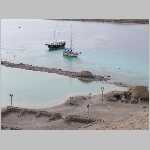 Safaris
Bergsteigen
Wandern
Inselwandern Weltweit
Safaris
Bergsteigen
Wandern
Inselwandern Weltweit
 Europa
Inselwandern
Europa
Inselwandern
 Städtewandern
Städtewandern
 Paintings
Paintings Dirk Rauschenbach
Dirk Rauschenbach
 Safaris
Bergsteigen
Wandern
Inselwandern Weltweit
Safaris
Bergsteigen
Wandern
Inselwandern Weltweit
|
 Europa
Inselwandern
Europa
Inselwandern
|
 Städtewandern
Städtewandern
|
 Paintings
Paintings |
 Dirk Rauschenbach
Dirk Rauschenbach
|
|
zurück
Jordanien
Pharao Island Ägypten



Pharao Island Ägypten
Pharaoh Island Egypt
Pharaoh Island Egypt



Pharao Island, auch bekannt als Pharaoh's Island oder Geziret Fara'un, ist eine kleine Insel im Golf von Aqaba im Roten Meer, nahe der Küste der Sinai-Halbinsel in Ägypten. Die Insel ist vor allem für ihre historische Festung bekannt, die Saladin-Zitadelle (Qal'at Salah ed-Din), die im 12. Jahrhundert während der Zeit der Kreuzfahrer erbaut wurde.
Die Festung auf Pharao Island wurde von Saladin (Salah ad-Din), dem berühmten muslimischen Herrscher und Gegenspieler der Kreuzritter, errichtet. Sie diente als strategischer Stützpunkt, um die Handelsrouten und die Küstenlinie zu kontrollieren. Die Zitadelle ist ein beeindruckendes Beispiel mittelalterlicher Militärarchitektur und bietet einen faszinierenden Einblick in die Geschichte der Region.
Saladin-Zitadelle: Die Festung ist das Hauptziel für Besucher. Sie können die gut erhaltenen Mauern, Türme und Innenräume erkunden.
Aussichtspunkte: Von der Festung aus hat man einen atemberaubenden Blick auf das Rote Meer und die umliegende Landschaft.
Tauchen und Schnorcheln: Die Gewässer rund um die Insel sind bekannt für ihre reiche Unterwasserwelt und sind ein beliebtes Ziel für Taucher und Schnorchler.
Pharao Island liegt etwa 8 Kilometer südlich von Taba, einer Stadt an der ägyptisch-israelischen Grenze. Die Insel ist mit dem Boot von Taba oder anderen nahegelegenen Orten wie Sharm el-Sheikh aus erreichbar.
Beste Reisezeit: Die Monate von Oktober bis April bieten angenehme Temperaturen für einen Besuch.
Ausflüge: Viele Reiseveranstalter bieten kombinierte Touren an, die einen Besuch der Insel mit anderen Attraktionen in der Region verbinden.
Kleidung: Da es sich um eine historische Stätte handelt, ist bequemes Schuhwerk empfehlenswert, da man viel zu Fuß erkunden wird.
Pharao Island ist ein faszinierendes Reiseziel für Geschichtsinteressierte und Naturliebhaber gleichermaßen. Die Kombination aus historischer Bedeutung und natürlicher Schönheit macht die Insel zu einem lohnenden Ausflugsziel in Ägypten.
Pharaoh Island (also known as Geziret Pharaoh) is a small, historically significant island located in the Nile River in Egypt, near the town of Taba, at the northeastern tip of the Gulf of Aqaba. The island is famous for its ancient ruins, particularly the Pharaonic-style fortress, and its role in Egyptian history.
Location and Geography:
Pharaoh Island is situated in the Gulf of Aqaba, which is part of the Red Sea region. It lies near the Taba Heights area in South Sinai, a short boat ride from the mainland of Egypt. The island is strategically positioned at the intersection of the Gulf of Aqaba and the Red Sea, giving it a commanding view of the waters.
The island is relatively small, with a total area of around 0.2 square kilometers.
Historical Significance:
The island's most famous feature is its **medieval fortress, built by the Crusaders during the 12th century. The Crusader castle on the island is one of the best-preserved examples of military architecture from the Crusader period in the region.
The fortress was originally constructed during the Crusades as a military stronghold to protect the Red Sea trade routes. It was used as a strategic outpost and played a key role in the conflicts between the Crusaders and the Ayyubid and Mamluk forces in the area.
Pharaoh Island also has historical ties to ancient Egypt, as it is believed to have been a location used by the ancient Egyptians for various purposes, including trade and defense. However, its most prominent historical features date back to the medieval period during the Crusader and later Ottoman rule.
Pharaonic Fortress and Crusader Castle:
The most notable structure on Pharaoh Island is the Crusader fortress, which is sometimes mistakenly referred to as Pharaonic due to its name. The fortress was originally built by the Crusaders and later rebuilt and expanded by the Ottomans in the 16th century.
The castle was designed to defend the Gulf of Aqaba from pirates and to control the strategic waterway. Its location on the island allowed for excellent surveillance and defense of the surrounding sea lanes. The structure is well-preserved, with high walls, towers, and a moat.
The main tower offers a panoramic view of the Gulf of Aqaba and the surrounding mountains, making it an important vantage point for visitors.
Cultural and Archaeological Importance:
The island is home to a number of archaeological remains, including the fortress, ancient ruins, and a well that was used for water storage. These ruins offer insight into the military architecture of the Crusader and Ottoman periods.
While most of the island’s historical significance comes from the medieval period, it is also thought to have had some earlier significance in ancient Egyptian history, as the Egyptian name suggests a connection to the Pharaohs.
Tourism and Activities:
Pharaoh Island has become a popular tourist destination, particularly for those interested in history, archaeology, and military architecture. Visitors can explore the Crusader fortress, walk along the island's beaches, and take in the beautiful views of the Red Sea.
The island is also popular for scuba diving and snorkeling. The surrounding waters are rich in marine life, making it an excellent spot for underwater exploration.
The island is often included in day trips from Taba and the surrounding Sinai resorts, where tourists can enjoy the historic sites and the natural beauty of the island and the Gulf of Aqaba.
Accessibility:
The island is easily accessible from the mainland via boat trips that depart from Taba or nearby resorts. Most tours offer guided visits to the fortress, with time for swimming or relaxing on the island's beaches.
Pharaoh Island is an archaeological and historical gem in Egypt, known for its Crusader fortress, which is well-preserved and provides visitors with a fascinating glimpse into medieval military architecture. The island’s strategic location in the Gulf of Aqaba made it an important site in both ancient and medieval history. Today, it offers a unique blend of historical exploration, natural beauty, and water-based activities such as diving and snorkeling.
Would you like to know more about the history of the Crusader castles, activities around Pharaoh Island, or perhaps details on getting there?
Amman Aqaba Berg Nebo Madaba Jerash Petra Qasr Amra Q.Azraq Q.Kharana
Kerak Pharao Island Ägypten Royal Diving Club Totes Meer Umm Qais Gadara
Wadi Mujib Wadi Rum Gemälde von Jordanien Jordanienlinks
![]() 26.07.25 Copyright Dirk
Rauschenbach Koelnerstrasse 293 51702 Bergneustadt
Datenschutzerklaerung 02261 9788972 Mail ccooly(
at) web.de
26.07.25 Copyright Dirk
Rauschenbach Koelnerstrasse 293 51702 Bergneustadt
Datenschutzerklaerung 02261 9788972 Mail ccooly(
at) web.de